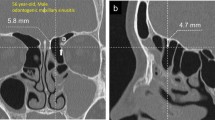Abstract
The frontal sinus outflow pathway is complex and can be influenced by the configuration of the uncinate process (UP). The UP can attach superior to the lamina papyracea, skull base, and middle turbinate. The factors associated with superior attachment remain unclear. This study analyzed the relationships between different types of superior UP attachment and characteristics of the surrounding structures including the agger nasi cell, skull base, and middle turbinate. This retrospective study utilized computed tomography images of 836 sides with identifiable sinus structure from 434 Taiwanese patients. Types of superior UP attachment, height of the ethmoid cribriform plate, prevalence of agger nasi cell, and degree of pneumatization of the middle turbinate were analyzed. In the current study, neither the presence of an agger nasi cell nor height of the cribriform plate had significant relationship with superior UP attachment type. However, UP attachment type was statistically significantly associated with pneumatized middle turbinate (PMT) type (p < 0.01). The PMT group had a higher incidence of UP attachment to the middle turbinate (38%) than the non-PMT group (18%). In the extensive PMT group, the incidence of UP attachment to the middle turbinate was high to 49%. In conclusion, superior UP attachment to the middle turbinate was associated with pneumatization of the middle turbinate. The UP has a greater tendency to attach to the middle turbinate in cases with more PMT.




Similar content being viewed by others
References
Wigand ME (1981) Transnasal ethmoidectomy under endoscopical control. Rhinology 19:7–15
Stammberger H, Hawke M (1991) Functional endoscopic sinus surgery: the Messerklinger technique. Decker, Philadelphia, pp. 61–90.
Landsberg R, Friedman M (2001) A computer-assisted anatomical study of the nasofrontal region. Laryngoscope 111:2125–2130
Ercan I, Cakir BO, Sayin I, Başak M, Turgut S (2006) Relationship between the superior attachment type of uncinate process and presence of agger nasi cell: a computer-assisted anatomic study. Otolaryngol Head Neck Surg 134:1010–1014
Zhang L, Han D, Ge W, Xian J, Zhou B, Fan E et al (2006) Anatomical and computed tomographic analysis of the interaction between the uncinate process and the agger nasi cell. Acta Otolaryngol 126:845–852
Liu SC, Wang CH, Wang HW (2010) Prevalence of the uncinate process, agger nasi cell and their relationship in a Taiwanese population. Rhinology 48:239–244
Wormald PJ (2003) The agger nasi cell: the key to understanding the anatomy of the frontal recess. Otolaryngol Head Neck Surg 129:497–507
Angelico FV Jr, Rapoport PB (2013) Analysis of the Agger nasi cell and frontal sinus ostium sizes using computed tomography of the paranasal sinuses. Braz J Otorhinolaryngol 79:285–292
Bolger WE, Butzin CA, Parsons DS (1991) Paranasal sinus bony anatomic variations and mucosal abnormalities: CT analysis for endoscopic sinus surgery. Laryngoscope 101:56–64
Perez-Piñas, Sabaté J, Carmona A, Catalina-Herrera CJ, Jiménez-Castellanos J (2000) Anatomical variations in the human paranasal sinus region studied by CT. J Anat 197:221–227
Unlu HH, Akyar S, Caylan R, Nalca Y (1994) Concha bullosa. J Otolaryngol 23:23–27
Maru YK, Gupta Y (1999) Concha bullosa: Frequency and appearances on sinonasal CT. Indian. J Otolaryngol Head Neck Surg 52:40–44
Keros P (1962) On the practical value of differences in the level of the lamina cribrosa of the ethmoid. Z Laryngol Rhinol Otol 41:809–813
Mahmutoglu AS, Celebi I, Akdana B, Bankaoglu M, Çakmakçi E, Çelikoyar MM, Basak M (2015) Computed tomographic analysis of frontal sinus drainage pathway variations and frontal rhinosinusitis. J Craniofac Surg 26:87–90
Freitas AP, Boasquesvisque EM (2008) Anatomical variants of the ostiomeatal complex: tomographic findings in 200 patients. Radiol Bras J 41:149–154
Basak S, Akdilli A, Karaman CZ, Kunt T (2000) Assessment of some important anatomical variations and dangerous areas of the paranasal sinuses by computed tomography in children. Int J Pediatr Otorhinolaryngol 55:81–89
Neskey D, Eloy JA, Casiano RR (2009) Nasal, septal, and turbinate anatomy and embryology. Otolaryngol Clin North Am 42:193–205
Uygur K, Tuz M, Dogru H (2003) The correlation between septal deviation and concha bullosa. Otolaryngol Head Neck Surg 129:33–36
Uzun L, Aslan G, Mahmutyazicioglu K, Yazgan H, Savranlar A (2012) Is pneumatization of middle turbinates compensatory or congenital? Dentomaxillofac Radiol 41:564–570
Chaiyasate S, Baron I, Clement P (2007) Analysis of paranasal sinus development and anatomical variations: a CT genetic study in twins. Clin Otolaryngol 32:93–97
Badia L, Lund VJ, Wei WI, Ho WK (2005) Ethnic variation in sinonasal anatomy on CT-scanning. Rhinology 43:210–214
Yeoh KH, Tan KK (1994) The optic nerve in the posterior ethmoid in Asians. Acta Otolaryngol 114:329–336
Author information
Authors and Affiliations
Corresponding author
Ethics declarations
Conflict of interest
There is no conflict of interest.
Rights and permissions
About this article
Cite this article
Cheng, SY., Yang, CJ., Lee, CH. et al. The association of superior attachment of uncinate process with pneumatization of middle turbinate: a computed tomographic analysis. Eur Arch Otorhinolaryngol 274, 1905–1910 (2017). https://doi.org/10.1007/s00405-016-4441-3
Received:
Accepted:
Published:
Issue Date:
DOI: https://doi.org/10.1007/s00405-016-4441-3




